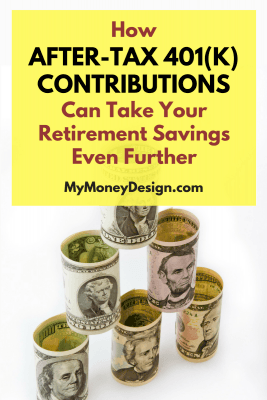After-tax 401(k) contributions may be your ticket to the next level!
It’s not very well known, but what most of us think of as the IRS max is actually just one piece of the puzzle.
The actual total amount of money that the IRS will allow both you and your employer to contribute to your 401(k) plan is actually quite a bit higher: $55,000 (for 2018).
For high-percentage savers and early retirement seekers, this information can be extremely useful.
But it’s also a strategy that comes with a few obstacles.
First, let’s understand what after-tax 401(k) contributions are.
Then we’ll see how they could be used to fit into our overall plan for financial freedom.
What Are After-Tax 401(k) Contributions?
What most of us think of as the IRS max limit ($18,500 for 2018) actually applies to what are known as “salary deferrals”. These are the contributions we make when we get our paycheck and decide to have some portion go into our 401(k) plan rather than our paycheck.
If you’ve got a traditional-style 401(k), then as you probably know:
Regular 401(k) contributions are pre-tax, or more accurately, tax-deferred. You won’t pay taxes on them now or while they accumulate earnings in the plan. But you will pay taxes on them someday in the future when you retire and withdraw the funds.
By contrast, after-tax 401(k) contributions are … taxable. You pay taxes on these contributions just like you would normally.
How are some contributions pre-tax and others post-tax?
To better answer this question, you need to look at the various methods for contributing to a 401(k) like pieces to a pie.
The total annual IRS contribution limit of $55,000 can be broken down into the following parts:
- Your pre-tax salary deferrals (up to $18,500)
- Employer matching contributions (decided by your employer)
- Profit-sharing (also decided by your employer)
- After-tax employee contributions (whatever is left-over)
Example:
Let’s say you contributed the full $18,500 to your 401(k) and your employer kicked in $7,500 between employer matching contributions and profit-sharing. That would leave you with the opportunity to make an after-tax contribution of:
$55,000 – [ $18,500 + $7,500 ] = $29,000
(Note: Catch-up contributions for those who are age 50 and over are NOT included as part of this limit. Therefore, they could theoretically contribute $55,000 + $6,000 = $61,000 alongside their employer.)
Why bother?
So if there’s no up-front pre-tax savings benefit from these types of contributions, then what’s the point? Why even bother to make these contributions?
The answer: Because just like your 401(k) provides you with some pretty significant advantages over traditional means of saving, these after-tax 401(k) contributions can also do the same.
Here are three important areas where you’ll gain an edge:
1- Tax Deferred Earnings
Even though your contributions may not be tax-deferred, your earnings will be.
Because the money is in your 401(k), the money that grows on top of your savings will continue to be tax-deferred.
That’s a big advantage over a traditional savings or investment account where you might owe taxes on the interest, capital gains, and dividends each year.
2- Ability to Make Withdrawals
Because you’ve already paid your taxes on these after-tax contributions, you have the ability to withdraw them tax and penalty-free at a later date if needed.
But there’s a small catch: If those contributions have accumulated any earnings, the IRS will assume that some of your withdrawal includes the earnings, and so a portion of taxes will be owed.
3- Back-Door Roth Conversion
Here’s the BIG reason: You have the opportunity to sneak the savings into a Roth IRA using something called a “back-door Roth conversion”.
This is a very popular loop-hole used by those who earn too much to still make contributions to a Roth IRA. In fact, this strategy let’s them contribute even MORE to a Roth IRA than you normally could in a given year.
Here’s a brief description of how it works:
- Make the after-tax contributions to your 401(k) plan.
- Request to make an in-service withdrawal where you move the money from the 401(k) to a Roth IRA.
(For a very detailed description of how to pull off a back-door Roth conversion, I recommend reading this article from Kitces.)
Because you’ve already paid taxes on these after-tax 401(k) contributions, there are no taxes owed at the time of the conversion.
The result: Because your savings are now inside of a Roth-style account, the earnings will grow TAX-FREE instead of tax-deferred. That means even more money stays inside your pocket when you decide to retire someday!
You Might Not Be Able to Do This
Now for the bad news: Your 401(k) has to allow you to do this. And unfortunately there’s a good chance that they won’t.
The rules for 401(k) plans are dictated by the plan administrator (e.g. your employer). So if they don’t want the hassle and headache of keeping track of which contributions are pre or post tax, then they can outright deny participants from making after-tax contributions or in-service withdrawals.
When I checked into my company’s plan, I unfortunately found out that they do not allow after-tax contributions. So this strategy is a no-go for me.
To know for sure, contact either your local HR representative or speak directly with the investment service provider.
Readers: Are you able to make after tax 401k contributions? If so, would you consider using this strategy to boost your savings or participate in a backdoor Roth IRA?
Photo credit: Pexels



Thanks for clearing things up for me a bit MMD! My employer DOES offer after-tax 401k contributions… but I was confused as to whether or not that automatically meant that it was a Roth 401k. I’ve heard of some companies who actually offer Roth 401k’s – and I was thinking that maybe the two things were one in the same.
In fact – I have a co-worker who is contributing to his 401k ONLY thru after-tax contributions and I think he is under the assumption that those savings are growing tax free like a Roth.
Just to be clear:
If your employer offers after-tax 401k contributions and your contributions have totaled less than the initial $18,500 limit, then they are going into a Roth 401k (if this is what you’ve selected) and they are growing tax-free.
This article is talking about contributions beyond the $18,500 limit.
Thank you for clearing this up. My employer does offer the after-tax option and I will be contributing to it, along with the max for the roth 401k maximum. I feel better knowing that I can save much more than I thought I could. I have not found in my plan documents that I can make in-service withdrawals. I will call and ask.
Thanks for sharing handful information on 401k contribution. I have been told by my employer that we can also opt for it, but I do not have any idea that how can I get benefit from this. I’ll definately talk to HR for sure.